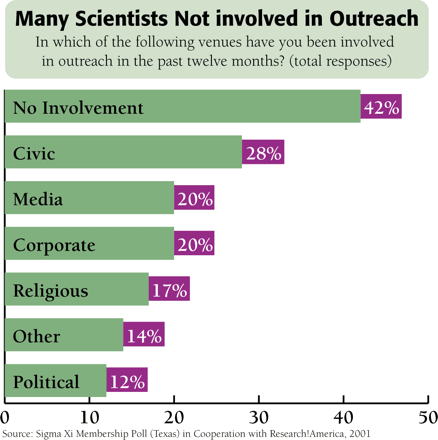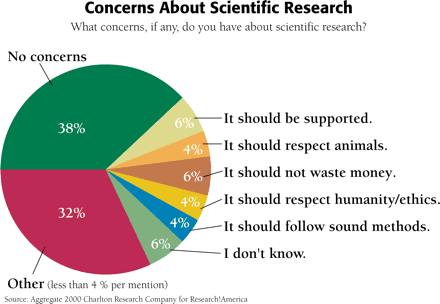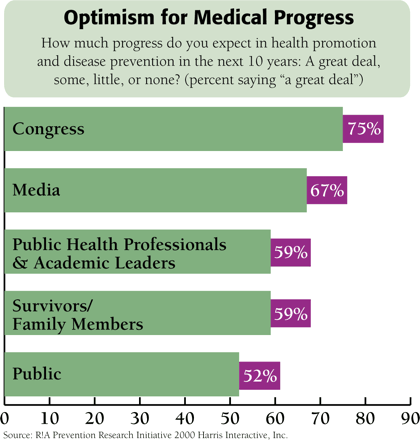Participating in SCIENCE OUTREACH a civic responsibility for scientists
- Ray Merenstein, Vice President of Programs,
- Matthew A. Bowdy, Director of Communications and
- Mary Woolley, President
- Address correspondence to RM. E-mail rmerenstein{at}researchamerica.org, fax 703-739-2372.
A challenge sits before scientists and researchers to rise to a higher plane and fulfill their civic responsibility as stewards of public money.
Leaders in science, ranging from former National Science Foundation director and White House science advisor, Dr. Neal Lane, to past president of the American Association for the Advancement of Sciences and current chancellor of the University California Santa Cruz, Dr. M.R.C. Greenwood, continue to encourage increased vigor and excitement for science outreach. Once thought of as something done in a local elementary school setting, outreach today has evolved to mean so much more.
Definitions of outreach are expanding, rationale for participating in outreach is growing, and best practices for modeling outreach are spreading. These three areas of science outreach — definition, rationale, and modeling — present justification for building up science outreach and, in particular, accountability of researchers to elected officials, civic leaders, and communities at large.
The call for action begins with employing the term “civic scientist.” This phrase brings two words together — the former referring to the body politic and the latter representing the furthest thing from the body politic. The phrase was used often by Dr. Neal Lane when he, as head of the National Science Foundation, was visiting Rotary Clubs and other civic groups in an effort to sell the hope of science, and convince taxpayers of the value of the projects they were funding. In his words, “[Science has] a good story to tell, and that story has to be told. Moreover, it has to be sold.”1
A second descriptor of science outreach comes from the varying views and disciplines of members of the scientific honor society, Sigma Xi. Based on Research!America focus groups in North Carolina and Michigan and e-mail surveys of Sigma Xi members in Alaska, Delaware, Ohio, and Texas, the definitions of outreach are as far-reaching as the potential of basic research itself. In fact, the volunteered examples of outreach include speaking to civic groups, talking with the media, lecturing to non-science audiences, writing or calling an elected official, and more (see graphic).2 However, those actually engaged in any one area of outreach on a consistent and frequent basis are less than one in five.
From both Dr. Lane's explanation and Sigma Xi opinions, one rationale emerges for why movements such as animal rights groups remain a constant challenge to stakeholders in research. Such groups have done outreach to a much greater extent and with much higher intensity than has the science community.

But the tide is changing, particularly with the rise in public support of sciences and the endorsement of legislators for increases in federal agency research budgets (e.g., fiscal year 2000 budget increases for National Institutes of Health, National Science Foundation, and Centers for Disease Control and Prevention of 14, 14, and 28 percent, respectively).3 This complements the greatest of all rationale, the progress of science itself: new imaging and diagnostic technology, faster and more accurate computations, advanced treatment and prevention of disease, and the new biology and breakthroughs in the mapping of the human genome. The resulting combination of public opinion, political will, and scientific opportunity is a mantra of Research!America in the effort to make medical and health research a higher priority.

Since its founding in 1989, Research!America has gauged public opinion, tested outreach materials, and designed advocacy models. Today, Research!America's membership represents over 400 organizations, ranging from health professional schools and professional societies to independent laboratories, voluntary health agencies, and industry. Not one of these groups is immune to the vocal minorities comprising the animal rights movement and anti-biotechnology protestors. Thus, each stakeholder in research bears the civic responsibility of outreach.
Researchers must recognize, and utilize, the resources and tools for outreach that are available to them via groups like Research!America, the Foundation for Biomedical Research, Americans for Medical Progress, state-based organizations, professional societies, and academic institutions. Stakeholders should realize and espouse the public's support of research. Every year since 1992, Research!America has asked if the use of animals in research is necessary for progress in medicine. The majority answer has been affirmative, as more than 70 percent of respondents believe the use of animals in medical research is necessary for progress. In addition, less than 5 percent of those surveyed mention animal research as a concern when posed with the open-ended opportunity to list any apprehension regarding the conduct of scientific research (see graphic, left).
Meanwhile, a recent series of polls of Congressional staff, survivors of preventable disease, general public, and academic leaders/public health professionals cites dramatic progress in disease prevention and health promotion over the past ten years and reflects optimism for the next ten (see graphic, below). Thus, the definition and rationale for outreach are clear. All that is now needed is vocal and committed advocates.

Here's how you can help:
-
When you see a story in your local newspaper about a research issue that is of importance to you, write a letter to the editor or call and talk with the journalist who wrote the story.
-
When you receive a research grant, write your Congressional representatives, thanking them for providing strong research budgets on behalf of the American public.
-
Visit Research!America's Interactive Advocacy Center (www.researchamerica.org). From there, you can write to President Bush and Congress, urging them to continue strengthening the medical and health research enterprise with strong funding of research budgets.
-
Speak out on behalf of medical and health research at town meetings and before community groups. Visit the “Talking Points” section of Research!America's Web site to find information about what is possible with more medical and health research.
-
Mentor a student or postdoc, not just in science but also in outreach. Encourage them to call their congressperson, write a newsletter article or address a local business or civic group.
-
Join a voluntary health organization like the American Cancer Society, March of Dimes, the Juvenile Diabetes Research Foundation International, or the American Heart Association.
-
Start listing outreach activities on your CV alongside publications and awards; give credence to the value of such action.
-
Take pride in outreach, as you take pride in your research.
As Dr. M.R.C. Greenwood noted in a presentation to the American Association for the Advancement of Science, “The motivation to be a civic scientist comes from a different place in one's being — the citizen rather than the scientist. It is from that sense of being a citizen that the most impassioned commitment to service can be made.”4
Footnotes
-
↵1 Neal Lane, Ph.D., William D. Carey Lecture, 26th Annual AAAS Colloquium on Science and Technology Policy, May 3, 2001, Washington, DC.
-
↵2 Research!America/Sigma Xi, survey of Sigma Xi Texas membership, 2001, Alexandria, VA.
-
↵3 Hon. Paul G. Rogers. Proposed Research Budget: A Starting Point [Letter to the Editor]. Science 2001 April 20; 292, 437.
-
↵4 MRC Greenwood, Ph.D., “Civic Scientist/Civic Duty.” Presentation at AAAS Annual Meeting. February 16, 2001.
- © American Society for Pharmacology and Experimental Theraputics 2001



